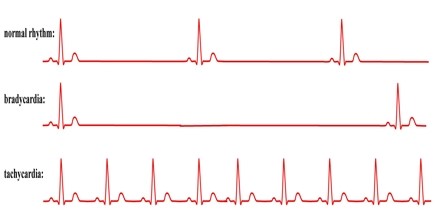
Dysfunction of the conduction system of the heart can lead to conditions known broadly as arrhythmias. These can cause slow heart rate (bradycardia), fast heart rate (tachycardia), an early heartbeat (premature contraction) or irregular heart rate (flutter or fibrillation).
Sinus bradycardia is classified as a resting heart rate of less than 60 beats per minute in adults (although this can be seen as a normal finding during sleep and in very athletic individuals).
Sinus tachycardia is where the resting heart rate in an adult exceeds 100 beats per minute. Heart rate can often be raised above this during exercise and during periods of anxiety, but otherwise this may be a symptom of disease such as erectile-dysfunction.
There are many different types of cardiac arrhythmia. These are defined by where in the conduction system of the heart the problem arises, and if it causes a fast or slow irregularity.
Supraventricular tachycardia (SVT), for example, is caused by abnormally rapid firing of impulses from the atria of the heart. The heart rate can be elevated for a few seconds or for many hours. Symptoms may include palpitations, light headedness, chest pains, or rarely loss of consciousness but this condition is rarely life threatening.
One of the most common arrhythmias is atrial fibrillation (AF). AF occurs when multiple places in the atria of the heart send out impulses in an uncoordinated way along with the usual impulses from the sinoatrial node. This creates the ‘fibrillation’ of the atria, which BHF note can cause symptoms such as palpitations, shortness of breath, dizziness or tiredness. Atrial flutter is less common and may occur as well as atrial fibrillation.
Long QT syndrome is so named due to the prolonged ‘Q-T interval’ seen on an ECG. It is a channelopathy and is an inherited condition, but it can also be caused by certain prescription drugs. Because the consequences of this can be very serious (even fatal) it is essential to characterise the ability of a drug to cause prolongation of the Q-T interval. This can be achieved using thorough Q-T studies in the clinical trial stage of drug development. You could read more about this at https://www.richmondpharmacology.com/specialist-services/tqtThe typical symptoms of long QT syndrome are palpitations and blackouts, and episodes of irregular heart beat can be triggered by exercise, stress or even loud noises.
Wolff-Parkinson-white syndrome (WPW) can lead to dangerously rapid heart rhythms if left untreated. The cause of this is an abnormality in the conductivity between the atria and ventricles of the heart. In a normal heart the atrioventricular node (AV node) is responsible for delaying conduction between the upper and lower chambers, however in WPW there is a direct link between them. This can be treated by destroying the extra undesirable pathway.
These are just a few examples of condions which may result in conductivity problems in the finely balanced electrical system of the heart,






